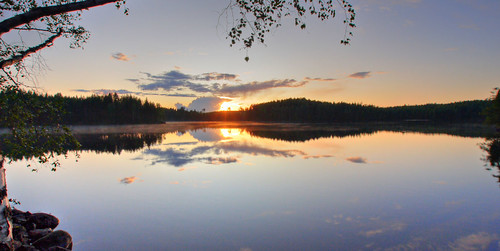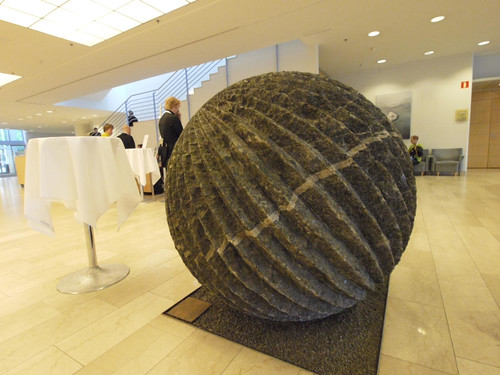 Most people's DSLR cameras are 4/3, APS or Full frame; all of which refer to things smaller than and up to the size of 35mm. Most are however APS.
Most people's DSLR cameras are 4/3, APS or Full frame; all of which refer to things smaller than and up to the size of 35mm. Most are however APS.The diagram to the left shows the comparison in size between APS and 4/3rds (green and yellow) over the Full frame. There really isn't much difference between them in comparison to Full Frame.
One of the things which is an issue for using a smaller format camera like the G1 is how well it works with wide angle photography.
You see, to get a wide angle view you need short focal length lens, but as the format gets smaller you need to have that focal length shorter and shorter.
People seem to get all lost on photography (perhaps because they get caught up in thinking in terms of brands features and functions rather than just grasping the elementary basics, but hey where is the fun in learning the facts when you can be dazzled more easily by magic right?).
 It goes like this: you're after wide angle, meaning you want to capture more of left to right than you think of as 'normal' ... To pick an example wide angle I'll choose 24mm focal length on a Full frame camera. This works out to capture 73 degrees of view.
It goes like this: you're after wide angle, meaning you want to capture more of left to right than you think of as 'normal' ... To pick an example wide angle I'll choose 24mm focal length on a Full frame camera. This works out to capture 73 degrees of view.Pretend that the lens is a single pinhole in a flat pate (heard of pinhole cameras?), so depending on the sensor format you are using you need to put the sensor at a specific distance from the 'lens'.
Looking at the diagram to the left you can see the blue line represents the width of the full frame sensor, and is at 24mm from the center (lets keep this simple here). A 4/3rds camera has a smaller sensor right? So for a 4/3rds camera (with its smaller sensor) it needs to be closer to have the same image projected on the sensor. This works out to needing a 12mm focal length lens.
So essentially a wide lens such as a 24mm on a Full Frame system works out to be a 12mm on a 4/3rds.
For ages a "standard wide" length in Full Frame was 28mm, but many people (rightly) feel that this is not really wide enough. It may not seem like a lot but in fact going from 28mm to 24mm makes a difference.
So with the "kit" lens being 14-45mm (similar to 28-90) wide angle fans are left scratching their heads. There really isn't much in the 12mm or less focal length range.
Two potential lenses are Panasonic's 7-14mm lens which is really wide but at over €1000 leaves people wondering if there are other options. Olympus makes a 9-18mm lens which is perhaps the next logical choice and at less than €600 is often considered. I paid about €100 for the adaptor, so this brings them closer together in price.
There are several tests of the Oly which you can find on the net, not much yet about the Panasonic and very little to say what people think about each. A common question though is what they look like and how do they compare to each other.
 To answer that question I have written this page.
To answer that question I have written this page.On the left is a picture (kindly provided by a member of a good forum on 4/3rds cameras) of the Kit 14.45 beside the Panasonic, owners of a G1 will likely be familar with the kit lens so it makes a good reference. You can see that the Panasonic really is very very similar in size to the kit lens.
Its important to note that the Panasonic 7-14 has a very bulging front element, thus it has a permanently mounted hood (as much for protection of the element as anything in my opinion). This however detracts from the lens in that you can not use any filter with the lens (yes, no polarizer, no Cokin gradutated filters ... nothing).
 I have taken an image to compliment the one above and place my 14-45 so that we could compare them side by side. As this image shows, the Olympus is a little larger and a little fatter. Notice that I have got the lens mounted on the required 4/3rds to micro 4/3rds which is needed to use this lens on the G1.
I have taken an image to compliment the one above and place my 14-45 so that we could compare them side by side. As this image shows, the Olympus is a little larger and a little fatter. Notice that I have got the lens mounted on the required 4/3rds to micro 4/3rds which is needed to use this lens on the G1.Sorry if the perspective is not perfect, and I left the filter on my kit lens, but apart from the shock transfer between the 14-45's middle you can easily compare the Panasonic to the Olympus at the exact same scale.
To me the Panasonic looks quite similar in size to the kit lens, and the Olympus looks larger but not really by much. I remember when I first opened the box and pulled the Olympus out that it looked small ... much smaller than my previous Tokina 12-24 which I used with my 10D
But the surprise came when I put it on the camera ... you need to see how they look on the camera to get the point, so here this is below:
(please be patient with this image loading, blogger doesn't host animated gif (converts them to something else) so its coming from a slower server).

Its really interesting to see it mounted on the camera, as while the Olympus looks a little larger than the Panasonic you really need to keep in mind just how compact the G1 Camera is.
 In use it makes the camera more like a viewing screen for the lens. The camera becomes insignificant and the whole thing kind of reminds me of the Sony F717 I used.
In use it makes the camera more like a viewing screen for the lens. The camera becomes insignificant and the whole thing kind of reminds me of the Sony F717 I used.I didn't mind it, and in fact it made a nifty handle for shooting at different angles.
If you only have the 14mm wide kit lens and are wondering how different the two are I've put a couple of images below to show you how much wider you get when going from
14mm
 to 9mm
to 9mm
This can be tricky to handle but works well in tight indoor situations. Clearly there are good outdoor wide angle opportunities too. Getting rid of foreground can be tricky and depending it might be as good for single shot panaroma like below.

Perhaps stitching and panorama is better use of the camera, but of course can't always be used in every situation. So when you need wide the 9mm is wide enough to get it all in one shot. The image quality of the lens will cope with it too and I am totally satisfied with what it gives, I was at a conference during the week and used the lens to make some interesting images there.

the ability to hold the camera in different ways (with its tilting swiveling screen) is excellent for working creatively with this lens. Although you do need to be careful with people shots as the strength of how wide it can be may give effects some may not like such as below ...

What I can say, he isn't really an Egg head.
However after using the lens for about 2 months is that it focuses really slowly, and it hunts quite a bit if you are in lowish light. Now I'm used to a diversity of cameras, from EOS 35mm SLR cameras (and yes, with wide angle lenses like the EF24 f2.8 which is not USM) through to to a little Nikon "prosumer" camera from 2001 (an era not noted for making fast focusing digital cameras).
So when I say (in the above company) the Oly can focus slowly (with a little machine like whirring) and hunts about a bit I really mean it.
Further you don't get Continuous AF only AF-S.
On the upside, the Panasonic G1's manual focus system (with its engagement of zoom focus in the focus point) really comes in handy, so you can intervene or simply leave the camera on manual focus and keep the aperture to f8 or something.
Neither lenses provide image stabilisation, and both weigh about the same. Technically the Panasonic is slightly heavier, but with the Olympus you need to add in the adaptor.
summary / conclusion
The Olympus is a nice lens gives great images and isn't too bulky. I like that I can mount filters like my Cokin system on it and that it is wide enough for my preferences.Its well priced although with the adaptor required isn't so far away from the Panasonic lens in price.
So in the end I think its not an easy decision. I feel that the price for entry into Wide Angle lens is high on the G1, enough so that you can really consider getting an EOS 5D with a 24mm lens for not much more. So if you are considering this you need to ask youself a number of questions, not just about cost and filters but about handling ease of use and system compatiblility.











2 comments:
nice write up. it was very very informative for a beginner like me. do you know how the c-mount lenses are doing in terms of crop factor? seems like people are getting the whole image circle - so no crop?
Hi Shakir
Good question ... worth a separate blog post.
Post a Comment